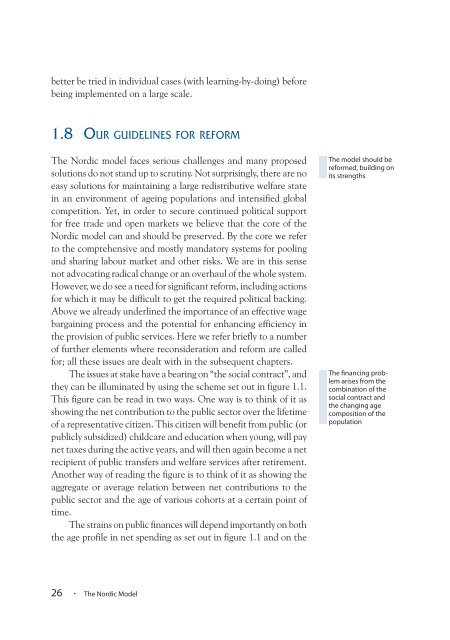The Nordic Model - Embracing globalization and sharing risks
The Nordic Model - Embracing globalization and sharing risks
The Nordic Model - Embracing globalization and sharing risks
Create successful ePaper yourself
Turn your PDF publications into a flip-book with our unique Google optimized e-Paper software.
etter be tried in individual cases (with learning-by-doing) before<br />
being implemented on a large scale.<br />
1.8 OUR GUIDELINES FOR REFORM<br />
<strong>The</strong> <strong>Nordic</strong> model faces serious challenges <strong>and</strong> many proposed<br />
solutions do not st<strong>and</strong> up to scrutiny. Not surprisingly, there are no<br />
easy solutions for maintaining a large redistributive welfare state<br />
in an environment of ageing populations <strong>and</strong> intensified global<br />
competition. Yet, in order to secure continued political support<br />
for free trade <strong>and</strong> open markets we believe that the core of the<br />
<strong>Nordic</strong> model can <strong>and</strong> should be preserved. By the core we refer<br />
to the comprehensive <strong>and</strong> mostly m<strong>and</strong>atory systems for pooling<br />
<strong>and</strong> <strong>sharing</strong> labour market <strong>and</strong> other <strong>risks</strong>. We are in this sense<br />
not advocating radical change or an overhaul of the whole system.<br />
However, we do see a need for significant reform, including actions<br />
for which it may be difficult to get the required political backing.<br />
Above we already underlined the importance of an effective wage<br />
bargaining process <strong>and</strong> the potential for enhancing efficiency in<br />
the provision of public services. Here we refer briefly to a number<br />
of further elements where reconsideration <strong>and</strong> reform are called<br />
for; all these issues are dealt with in the subsequent chapters.<br />
<strong>The</strong> issues at stake have a bearing on “the social contract”, <strong>and</strong><br />
they can be illuminated by using the scheme set out in figure 1.1.<br />
This figure can be read in two ways. One way is to think of it as<br />
showing the net contribution to the public sector over the lifetime<br />
of a representative citizen. This citizen will benefit from public (or<br />
publicly subsidized) childcare <strong>and</strong> education when young, will pay<br />
net taxes during the active years, <strong>and</strong> will then again become a net<br />
recipient of public transfers <strong>and</strong> welfare services after retirement.<br />
Another way of reading the figure is to think of it as showing the<br />
aggregate or average relation between net contributions to the<br />
public sector <strong>and</strong> the age of various cohorts at a certain point of<br />
time.<br />
<strong>The</strong> strains on public finances will depend importantly on both<br />
the age profile in net spending as set out in figure 1.1 <strong>and</strong> on the<br />
<strong>The</strong> model should be<br />
reformed, building on<br />
its strengths<br />
<strong>The</strong> financing problem<br />
arises from the<br />
combination of the<br />
social contract <strong>and</strong><br />
the changing age<br />
composition of the<br />
population<br />
26 · <strong>The</strong> <strong>Nordic</strong> <strong>Model</strong>

















